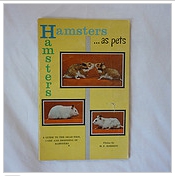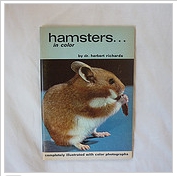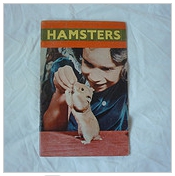Hamster Care Book Reviews - 1940s and 1950s
Hayner, Al, 1945, "Successful Hamster Raising", Courier Printing company. 105 pages, black and white photographs and illustrations, hardback. American.
4 stars - a little too much focus on cage-building instructions to be as readable as the Marsh book.
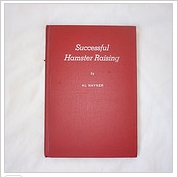
This book describes itself as "The most complete guide to the successful raising of Golden hamsters ever offered in the small stock field.". The majority of the book is now of historical interest only as it relates to the manufacture and design of self-built cages for the mass breeding of hamsters, and their basic care. However the later chapters give an interesting perspective on the motivations behind the early spread of hamsters in the US, for example listing possible uses for hamsters including novelty taxidermy gifts and fishing bait!
Graber, J. M., 1948, "Raising hamsters for Pleasure and Profit". American.
4 stars - a good deal of information, written for an adult audience.
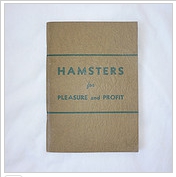
Whilst much of the advice is now outdated, this book goes into more depth and serious consideration of the practicalities of hamster care than many later guides.
For interest, here is a link to a contemporary issue of "Popular Mechanics" magazine featuring an advert for this book, to be given free with every pair of hamsters bought from a particular hamstery. The advert for Gulf Hamstery below it (and on page 32 of the same issue) refers to the hamstery of Albert Marsh, author of "The Hamster Manual". Yet another illustrated hamstery advert appears on page 30 of the same magazine.
Marsh, Albert F., 1948, "The Hamster Manual", Gulf Hamstery. 43 pages (but covered in dense type), brown and white photographs and illustration, paperback. American.
5 stars - this is pretty much the definitive guidebook to how hamsters were seen ten years after their introduction to America.
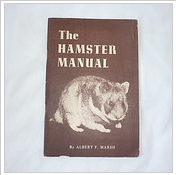
Although the preface clearly states "This book is intended to be a complete manual for the successful breeding and raising of Syrian Golden Hamsters. It is not an advertisement" the primary focus is the business of breeding hamsters commercially, as part of a pyramid-scheme type plan to profit by supplying home-grown stock to science labs (and to hobbyists and other potential breeders). Particularly interesting are the descriptions of how to build a cage, and hopes for future colour variations.
Reynolds, H. W., 1948, "Golden Hamsters: for fanciers, schools, all animal lovers.", A "Belvedere Booklet" No 1. 32 pages (but covered in dense type), black and white photographs and illustration, paperback. British.
4 stars - this is the earliest book on hamsters for the general public produced in the UK
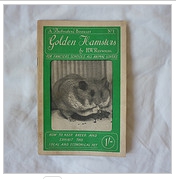
This booklet was produced by Mr Reynolds for the benefit of the brand-new Hamster Fancy in the UK. The 6 chapters of the booklet introduce the golden hamster, discuss housing and feeding, and then devote half of the book to breeding, record-keeping and exhibiting hamsters. The foreword to the booklet is written by Dr Edward Hindle of London Zoo, where hamsters had been bred and exhibited from their first introduction to the UK, and inside the back cover the National Hamster Council is advertised.
Mr Reynolds was a member of the earliest hamster clubs in the UK and held the show prefix 'Belvedere' for his animals - which was also the name of his house.
Eaton, O. N., 1948, "Hamster Raising" (Leaflet No. 250, Department of Agriculture), American
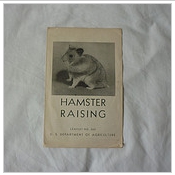
This is a short leaflet (6pages/two folded A4ish sheets) containing similar information to other contemporary hamster raising manuals although with less on cage-construction. It ends with a strong statement warning against allowing any colonies to establish in the wild where they would become a danger to "crops and gardens".
The full leaflet can be downloaded and read online legally here.
Cook, Jean E. 1948, "Hamster Guidance", British
An article describing this book can be found on the website of the now-defunct British Hamster Association.
Gale, Louis Clyde, 1949, "The golden hamster manual;: A message to raisers and users of Syrian golden hamsters", 73 pages
Cook, Jean E. 1940s, "The Golden Hamster" (Ditchfields Little Wonder Book 28a), British
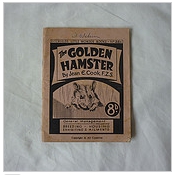
This booklet is undated but thought to date from the 1940s. It has the same title and number in the series as the Ditchfields Little Wonder Book by T.W. Pond, which may be a 1970s replacement. This booklet directs potential breeders to the British Hamster Club, and discusses several topics not so current today, such as "Sleepers" (hamsters who appear dead but then revive, as a nervous condition) and euthanasia by home-made gas chamber. It does state that hamsters have a non-poisonous bite to humans (but that their bite can go septic very easily in other hamsters)
Zim, 1951, "The Golden Hamster", American
4 stars - This book is one of the most charming and beautifully illustrated works of propaganda that I have ever seen. :)
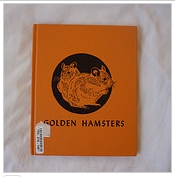
Although presented as a generic children's book all about Syrian hamsters (then known as golden hamsters) it swiftly turns out that the US Fish and Wildlife service and US Dept of Agriculture might have given their support to the author in producing this book because of the extremely strong message running through it, which can be summarised as "don't release golden hamsters into the wild in the US in case they get established and turn into a new agricultural pest".
Despite this, the book contains a reasonably large amount of solid pet care information as well as an unusually large amount of detail about hamsters in the wild (including a focus on the European hamster) and their potential predators and possible exponential breeding rates, and it is actually a good read. It is also of particular historical interest when considered alongside the hamster-raising manuals being produced five years earlier, which contributed to a giant explosion of hamster numbers in the USA.Asst., 1953, Hamster Guide: Compiled from the Most Outstanding Articles in All-Pets Magazine 1952, All-Pets Books, American
This book is 44 pages long and presumably composed of the articles referenced in "Hamster Guide" edited by Folk, 1958, and then again with exactly the same word-for-word bibliography/acknowledgement section in "Hamsters" by Folk, 1984.
"Articles that originally appeared in All-Pets Magazine. Included among these are: "General Notes on Golden Hamsters", "Buying Your First Hamster", "Handling Hamsters", "Housing Hamsters" Jean E. Cook F.Z.S.; "Housing and Equipment" H. W. Reynolds; "Importance of Milk", Leonore Brandt; "Hamsters in Medical Science", Dr Banner. Bill Morgan; "Care of Pet Hamsters" Earnest P. Walker."
All-Pets, 1955, Pet Hamsters
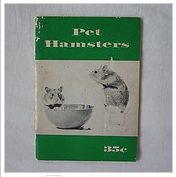
It is very unclear if this All-Pets booklet is somehow the one described immediately above, or another contemporary book by the same publisher. This one does not contain a curated set of diverse articles, but has an assortment of chapters on different hamster care topics much like other books of the time. It does not contain dedicated content on hamsters in Science.
Pond and Deaton, 1956, The Hamster Handbook, British
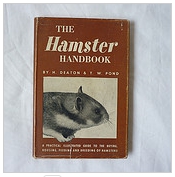
This book was the definitive hamster care manual in the UK for quite some time!
Roberts, M. f., 1958, "How to raise and train a pet hamster", TFH M-508, TFH Publications, Jersey City. Library of Congress No: 58-12554. 48 pages, black and white/colour photographs, paperback. American.
4 stars - an outdated but very interesting short book, giving interesting insight when contrasted with the modern equivalent
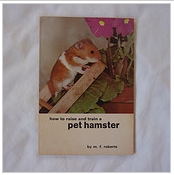
This book covers the basics of keeping pet hamsters from selection to eventual illness much as current pet care books do, but written for an adult audience who may never have seen a hamster in the flesh and with a few touches that date it (warnings against pet hamsters as a commercial venture as those niches are now filled, mention of some people keeping hamsters in a cage outdoors like guineapigs/rabbits, etc). Commercial premade cages are now coming in. Two particularly interesting sections of the book are the "Commercial tricks and techniques" section which describes a visit to a local mass hamster breeder for advice, and the "Hamsters in research" section which praises the advances in science made by 'humanely sacrificing' lab hamsters - which is very interesting although doesn't seem to make it into a similar children's hamster care books now.
Folk, Jr., Dr. G. Edgar, Edited and Revised By, 1958, Hamster Guide, All-Pets Books, American
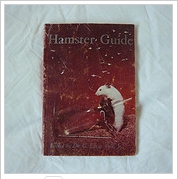
This book describes itself as deriving essentially from the combination of Graber (1948), All-Pets (1953) and Pond/Deaton (1956).
"Hamsters" by Folk (1984), TFH publishing seems to be very heavily based on this book and claims the same sources, although it is not a direct reprint.
